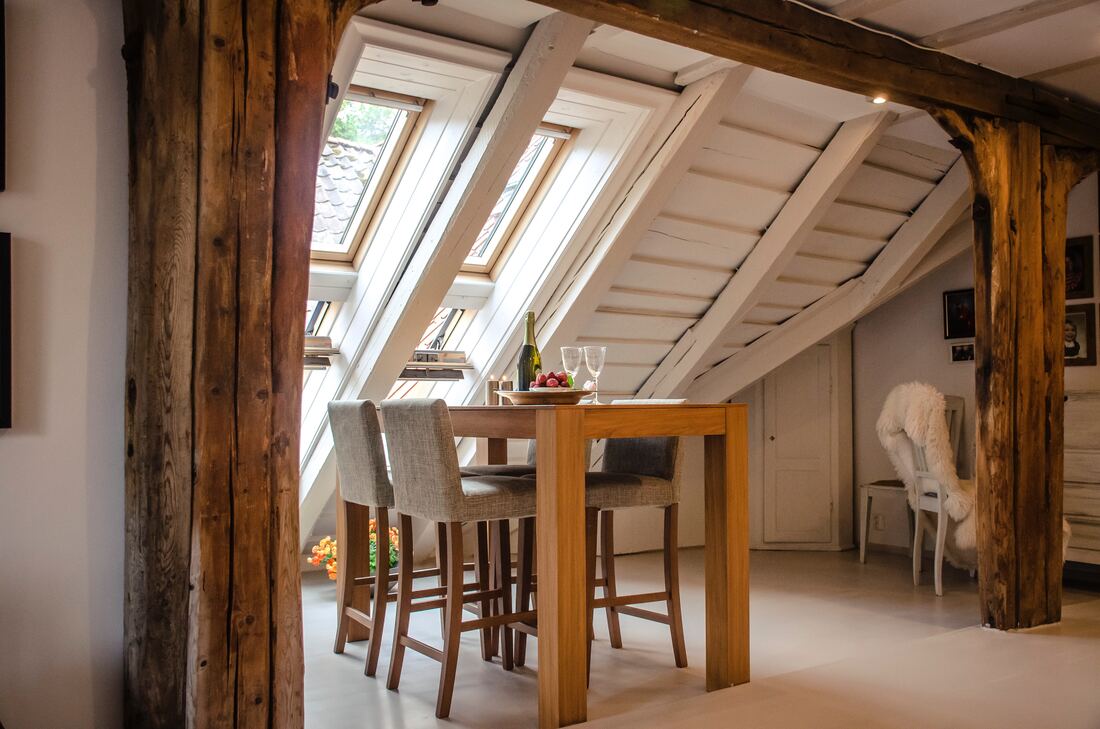Do you need more space in your home? A loft conversion is a welcome addition to any family home. Not only does it expand the space of your home, but it also significantly adds value to its sale price and provides an extra layer of insulation, meaning that you’ll cut your energy usage. Lofts tend to be one of the largest areas of unused space in a house, whilst also being the simplest to convert. Whether your dream loft conversion requires structural work or you’re planning on minor alterations to make the most of the space you already have, there are a few important things to consider in order to create the perfect design that suits your home, as well as your family’s needs. How much does a loft conversion cost?You may be wondering- if it’s extra space you’re after, why not just move to a larger house? Well on average, the cost of a loft conversion is one third of the cost of moving to another house with an extra room, meanwhile increasing the value of your home by up to 25%. With such vast financial benefits, it’s clear that choosing to take on a loft conversion is a worthy investment- but how much does it actually cost? The average loft conversion costs anything from £20,000 to £50,000, but this number, of course, depends on a list of variables. For example, are you adding a bathroom? How big is your existing loft space and how much are you hoping to extend it by? How much structural work is required? The final consideration has a significant impact on the price - if you can get away without having to perform any or only minor structural work, the cost of your loft conversion can drop dramatically. It’s up to you how you pay for your loft conversion. If you have a stricter budget, it may be worth working with a specialist loft company for an all-inclusive price so that you can stay within your allotted costs. On the other hand, you could find an architect or construction company to draw up the plans and then gather quotes from the relevant contractors. With the latter option, you’ll have to pay the various parties (builders, roofing specialists, door and window experts, etc), however, you’ll benefit from their specialist knowledge on each aspect of your renovation. Is my house suitable for a loft conversion?Once you’ve weighed up the costs and you’re happy to go ahead, you next need to work out whether a loft conversion is actually possible in your home. Most importantly, there needs to be at least 2.1m between the floor and the roof in the tallest part of your loft - for a comfortable bedroom or living room, at least half of the space should offer this amount of headroom. Not only will this ensure your conversion complies with building regulations, but it also means that you won’t be uncomfortably crouching or knocking your head. With their steeply pitched roofs, Victorian, Edwardian, Georgian and other pre-war properties are the perfect fit. You just need to remember to contact a chartered surveyor before the work goes ahead to ensure the building is structurally sound. After sussing out whether your loft is suitable internally, you’ll secondly need to work out whether you need to apply for planning permission. Most loft conversions fall under the ‘permitted development’ category, meaning that you won’t need planning permission to renovate your loft. However, if you want to add a balcony or terrace, your plans must be approved. Equally, if your house is listed or in a conservation area, getting permission may be more difficult. How can I make sure my loft design complies with Building Regulations?Whatever type of property you have, you’ll need Building Regulations approval. Your building contractors should ensure that your loft complies, however, it’s worth understanding the standard building regulations yourself so that you don’t get caught out after spending your hard-earned cash on your building project. Make sure you’re aware of these important rules:
What styles of loft conversions are available? What will suit your house and budget?When it comes to loft conversions, there are plenty of different options out there. The design you choose is predominantly down to how much space you want to add and your budget, however, it’s also important to consider planning restraints and the aesthetic impact of your chosen style on your house - it should fit the architectural style and not look like an add-on. There are four main loft styles for standard properties:
Conclusion - adding extra space will add value to your home So, whether you want to add an extra bedroom to your home, create a second living area or even flip your house upside down with a light and spacious open plan kitchen diner at the top of your home, a loft conversion could be the perfect addition. Just be sure to work with an experienced and accredited specialist loft company or architect and construction firm in order to design and build a loft conversion that looks beautiful and stands the test of time. The Paul Ennis Group offers building surveying, construction and architectural services to customers across the North West of England. The group has received accreditations for their services across the industry. When you choose to work with Paul Ennis, you can expect a high quality and professional service, every time.
30 Comments
Before starting excavation you must ensure that all underground services are known and have been clearly marked and pointed out to those doing the excavation. The dangers of damaging utility lines during constructionStriking a utility cable or pipe can:
Locating utility lines before constructionUtility lines can be located by:
protecting utility lines while building and renovating houses But it’s not just the existing lines that need protecting. Frequently workers dig up newly installed lines placed during construction. New lines must be clearly marked and protected. Unfortunately, on occasion cables and pipes are damaged, but the damage isn’t reported, or the person doing the excavation isn’t aware they damaged the line. This could lead to an undetected fault which only becomes apparent much later. Electrical cables which have their outer casing damaged could fail months later when water enters the cable. Water pipes could leak for months, making for very expensive water bills, only becoming apparent when the ground becomes saturated. Sewer and stormwater pipes could become filled with sand which enters through holes broken in the pipe, blocking the pipe, or causing areas above the pipe to settle. Unfortunately when the problem eventually becomes apparent it’s often difficult to locate the exact location, and invariably the area has been paved over, or has a concrete slab above it, or is grassed and landscaped. Fixing the problem can be costly, so it’s vital that all existing and new cables and pipes are protected, and that workers exercise extreme care when digging around known lines, immediately reporting any concerns that they might have, or where they may have inadvertently caused damage to the cable or pipe. But it’s not just underground lines we must be careful with. Overhead power cables can be extremely dangerous. Even equipment coming within a couple of metres (yards) of the line could cause the power to arc, or flash, between the cable and the equipment, damaging the equipment and possibly causing injury or death to the operator and bystanders. Be careful when carrying long ladders and objects under low overhead cables. Always stay well clear of fallen power lines and notify the utility provider immediately a power pole or overhead cable is damaged. Cables and pipes installed within the floors, walls and roofs of houses can easily be damaged by workers cutting and drilling. Countless almost completed houses have water pipes and power cables cut when fittings and fixtures are installed. These especially include when installing bathroom mirrors and towel rails. Not only is this dangerous, but it costs money to repair when tiles and walls have to be chopped open to fix the damage. Flooding from damaged water pipes can damage cupboards and floor finishes.  For more valuable tips and advice read: 'An Introduction to Building and Renovating Houses - Volume 1 Hiring Contractors, Managing Construction and Finishing Your Home' and 'Volume 2 Finding Your Ideal Property and Designing Your Dream Home' This is an extract from: 'An Introduction to Building and Renovating Houses Volume 1' by Paul Netscher. Available in paper or eBook from Amazon.com, Amazon UK, Amazon CA, Amazon AU and all online bookstores. To read more © 2019 This article is not to be reproduced for commercial purposes without written permission from the author. Thinking of renovating or extending your house? Home renovations range from minor cosmetic touches, like repainting a house, through to bigger changes, like redoing paving and constructing pergolas and verandas. Then there are more major changes, such as extending the house by adding additional bedrooms, bathrooms and garages. More complex and major changes could include structural changes and even adding an additional upper floor. There’re restrictions which could limit what you can and can’t do and what you can change in an existing house. These include:
 For more valuable tips and advice read: 'An Introduction to Building and Renovating Houses - Volume 1 Hiring Contractors, Managing Construction and Finishing Your Home' and'Volume 2 Finding Your Ideal Property and Designing Your Dream Home' This is an extract from: 'An Introduction to Building and Renovating Houses Volume 1' by Paul Netscher. Available in paper or eBook from Amazon.com, Amazon UK, Amazon CA, Amazon AU and all online bookstores. To read more © 2019 This article is not to be reproduced for commercial purposes without written permission from the author. |
AuthorI’m a construction professional, author of several successful construction management books, and a home owner. I’ve made mistakes in construction management, I’ve seen others make mistakes, but importantly I’ve had multiple successful construction projects and I’ve learned from the mistakes. I want to share these lessons and my knowledge with you. Also available from:
Amazon Au, Amazon DE, Amazon ES, Amazon CA, Amazon IT, Amazon FR, Amazon NL, Amazon India and 'An Introduction to Building Houses - Volume 2 Finding Your Ideal Property and Designing Your Dream Home'
Archives
July 2024
CategoriesWe welcome genuine comments, especially comments that add additional information to the subject matter in the article. We however reserve the right to remove inappropriate comments, which includes comments that have nothing to do with the subject, comments that include inappropriate language, and comments that are an advertisement for a product or company, or which include an advertising link. Comments must be in English. We will not enter into discussion on why a particular comment was removed.
|




 RSS Feed
RSS Feed


